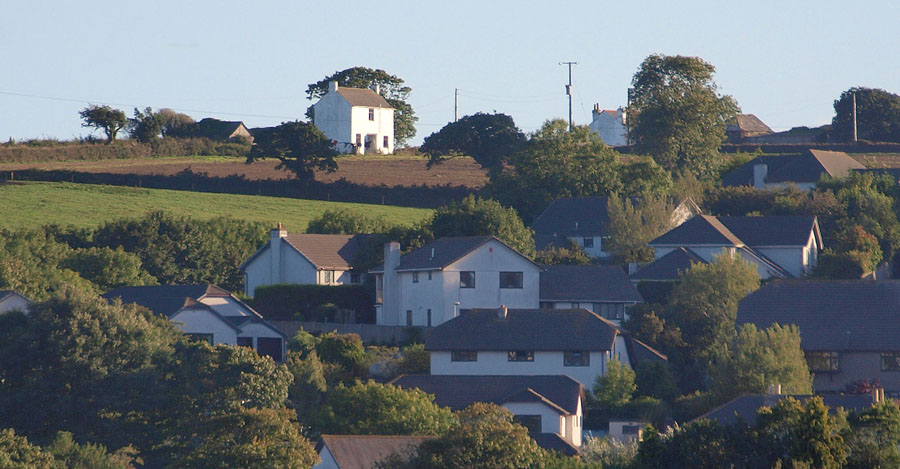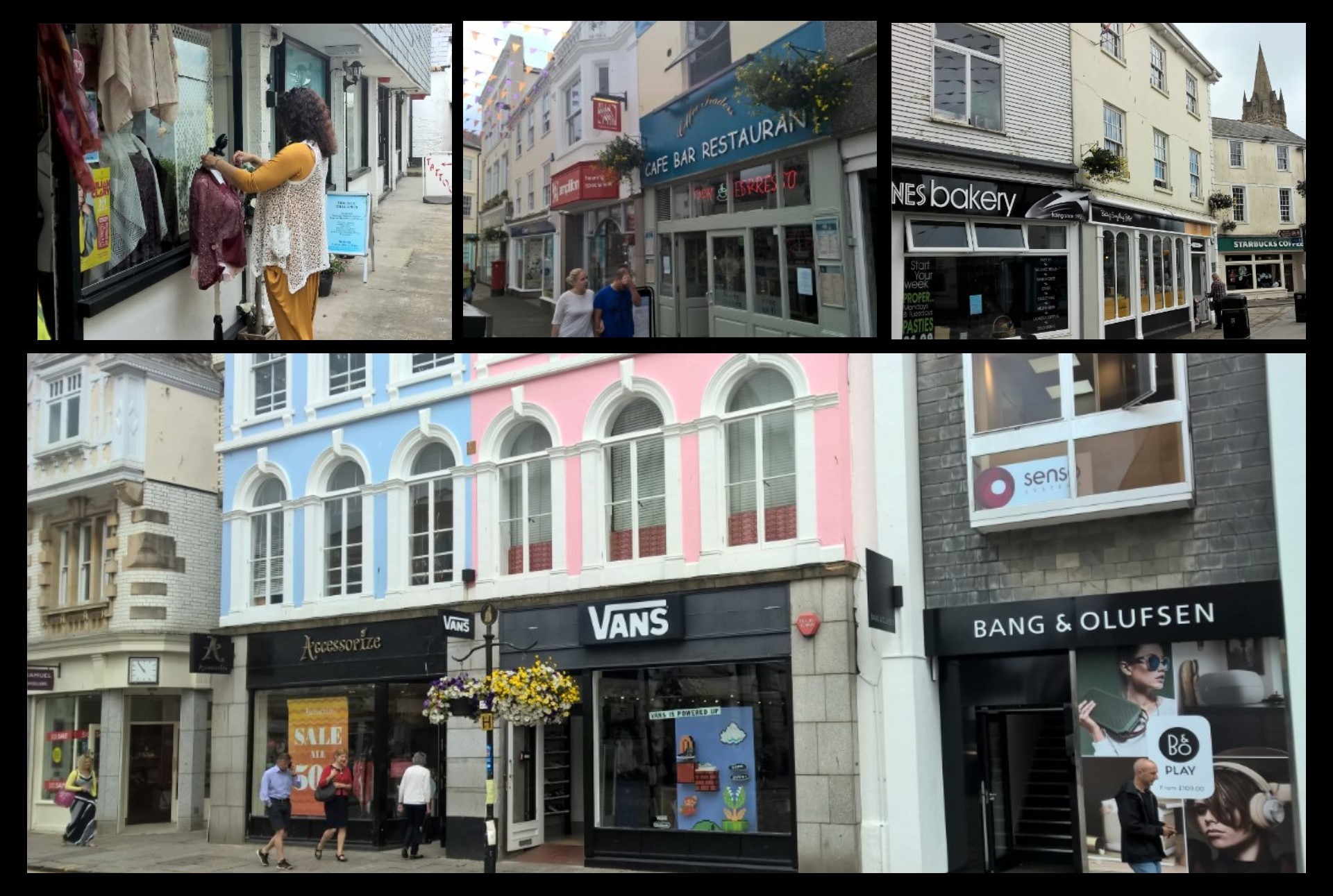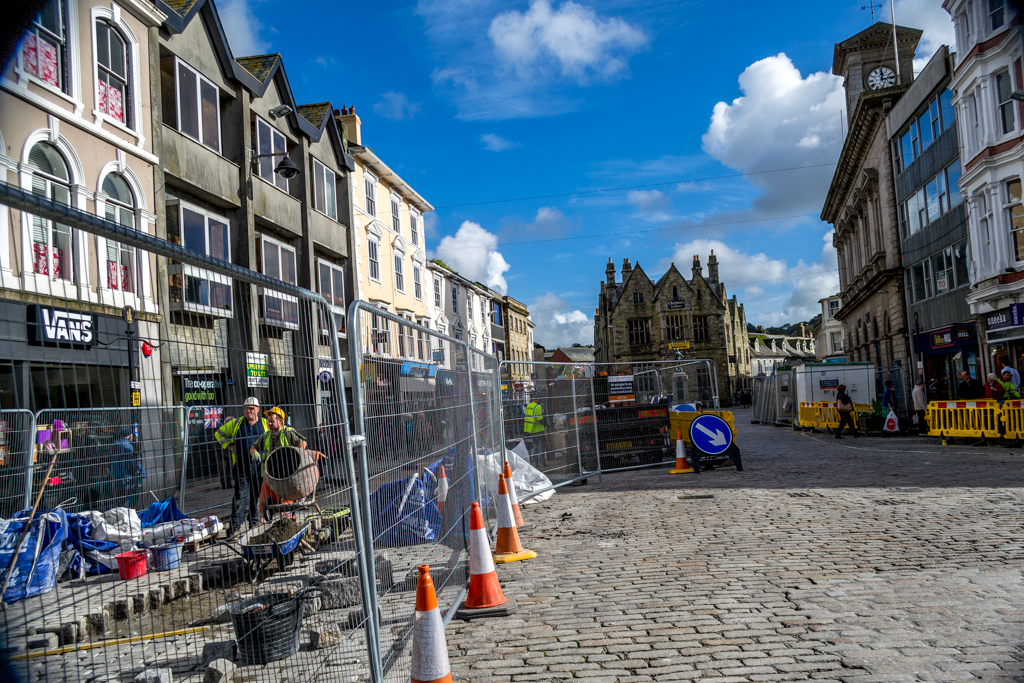Langarth Development
27th March 2020
Dear Langarthians,
I am writing from two perspective – Firstly, as the elected member for Boscawen Division, Truro, which embraces most of the central commercial area of the town.
Secondly, from a strategic perspective, considering the course of the town from its beginnings, and projecting how it will evolve as it goes along. Being a town with a deep causative purpose bound up in its location, it is less the assertive will of individuals than the existential cause and effect of its historical narrative, pulsed from within by creative, reactive, restless and complacent stresses, and affected by ebbs and flows of change in the wider world, in nature as much as in society, which propels the town to develop and change.
By way of preface, I remain to be convinced that the proposal for development at Langarth, or of development driven by bureaucratic planning more-so than by need, is sufficiently rooted in that historical narrative, or is sufficiently organic in scale or character, to be thought of as evolutionary, or whether it is merely a draconian intervention which contains within it the seeds of its own misconception and failure, and is driven by false associations of ‘city’, rather than the geography and ecology of its location.
If, as the various documents declare in various ways, under various headings, the project will ‘work with Nature, not against it’, and will utilise ‘sustainable drainage systems’ why do all the graphics illustrate a community living on the level. The whole site is on the northerly sloping drainage valley of Dowr Ithy (River Kenwyn). It will need to be very dramatically intervened upon, at depth, in order to create any degree of levelness – this will not only disrupt native soils which have been cultivable, and in production for 1000 years, but will also disrupt the underlying geology, which is mainly killas. The geology is the sustainable drainage system. It carries aquifers, spring water and watercourses, not to mention at least two streams, all of which contribute to the balanced flow of the River Kenwyn.
Nature isn’t just something which happens on the surface and at the Chelsea Garden Show! The geology, and the geological structures and formations upon which ‘land’ sits is an intrinsic component of natural landscape. The degree of re-modelling necessary to produce the outline vision will fundamentally change the natural infrastructure of this land, and no amount of attenuation, mitigation, sustainable design or ‘typologies bespoke to the natural setting’ will redress this fact.
If the design values mean what they say then the description of the experience being created should, if it is going to work with Nature, not against it’, prepare people to be living on sloping land – the aim should be to be minimal in our interventions and disruptions – to leave in-situ native soils so that future gardeners (I assume a garden village will have gardens), allotmenteers, naturalists and future generations can share in the benefits and resonances of Nature’s long and patient path from Big Bang to sustained fertility. If you wish to establish a place designed for art and culture to flourish then it needs to feel, in the spirit of that place, a sense of continuity, of earth, air, fire and water, to be a place where spriggans dance on moony nights. If you remove the geology then with what will all those ‘local materials’ be blending and integrating?
More to the point, if you disrupt the killas, where will the river gather its water from? Its not just a leat running down a tree-lined culvert; it’s a living and essentially defining part of what constitutes the natural world around it; it sets a rhythm; creates a subliminal music; hydrates; drains; irrigates; carries away rains; is a highway and habitat for fish, insects, plants and is a key ‘mill’ for the incessant rubbing together of minerals that ultimately manufactures soil. If this was a small development – say 5 houses – then it wouldn’t matter, but, if you study the OS map, the contours and location make it a large and critical area of land which is married organically, geologically, hydrographically to Dowr Ithy.
If you starve the river of water by disrupting its feeder network of aquifers, watercourses, springs and streams the this will affect the rate of flow and volume of fresh water down stream, especially in the delta area of Truro, where the town sits on the extensive flats, where fresh water flows down from the moors to meet the saltwater coming in on the tide – where the owl meets the heron; and Jay jams with the Curlew; where the Kingfisher and the Godwit trade hunting tricks; where the ‘push & pull’, the suction and saturation of the tidal motion create the stability in deep layers of siltation built up over millennia that provide both the estuarial habitat and the structural stability upon which the character and built environment of Truro rests. Disrupt or alter the balance of salt and fresh, change the rate of flow of river meeting incoming tide or chasing the ebb to sluice and detoxify, and you risk the town, or at least that part of it which has depended since its inception upon the living and delicately robust contribution of the River Kenwyn.
On the other hand, and bearing in mind the level of risk to Truro advised in the Shoreline Management Plan, and evidenced by the sophisticated flood management plan of the 1980s, allowing even the managed flow of run-off, and the un-managed flow in moments of extreme weather when the intensity of it simply overwhelms the management facilities, then you also risk over-feeding the river by creating a very large expanse of hard-standing and reduced absorbency over 650 acres of the Langarth development. This also risks the town for the opposite reason – inundatum in extremis, an effect probably significantly intensified by the terracing or other flattening approaches to be applied if the illustrated illusion of levelness is to be realized.
There is a further point to be made about sustainability. Truro is a town which evolved because the estuary can be forded at this point. It is a town built upon and over water, which relies on water for its essential character and purpose. It is here, indeed, in the same geographically causative way that London is where it is – at the first fording/bridging point over a major estuary, where empowering fresh water is meeting and connecting with salt water. The crucial point being that Truro only exists if it is able to operate uninhibitedly at this elemental crossroads. If we risk the stability, health conditions or future resources of that location, the town will be in critical jeopardy. The Langarth project holds the future sustainability of Truro in its hand – we all need to be very, very careful.
As we begin to develop new strategies (or reawaken old ones which have been set aside whilst we indulge ourselves in the consumption of natural resources to the point of extinction) for keeping the town going, supporting its community, and providing services, products, inspiration to our surroundings, it is important that we take stock of our assets. In doing so, we must of course consider the benefits and opportunities of technology; but we must also consider the sustainable harnessing of natural resources. In Truro this means asking how we can effectively harness our rivers, as our forebears did. The Kenwyn and Allen offer Truro a key future source of power generation, of irrigation and of cultural focus and inspiration.
The undershot waterwheel (preferable at sea level) offers significant potential. The advent of modern materials and engineering knowhow means that the modern wheel would not be a lumbering saturated great lump producing a low ratio of power. It will be a high-performance, low-impact technology capable of generating locally sourced good quality power – but only as long as the rate of flow and water levels of our rivers are consistent.
The risk from severe geological disruption of a critical upstream drainage valley-side is not simply to the land, but also to the sustainability of the community. This impact, whilst a factor for future development, is a vital element in contemplating the future of the town, and the port, and the economy as it shifts from the middleman back to the producer. It is the guiding principle of sustainability that we should only do things that will not impact upon the opportunities for future generations. We need to be very careful that, in building so many houses in such an unsustainable location in such an unsustainable manner, it will not have long and deep reaching impacts on the future opportunities of Truro and all who depend upon her – not least all those residents, workers and visitors whom you envisage will inhabit the Langarth Garden Village.
The Environmental Impact Assessment must look in depth, and using evidence such as that amassed by the Westcountry Rivers Trust, determine what the fundamental change in aspect of this large area will mean for drainage of the moors, the life of Dowr Ithy, the future stability and protection of Truro, and the way in which Nature is able to evolve after such draconian interventions. Better that you aspire to much less, and work with the geology, the contours, the water and the resonances of Nature – much better than empty vacuous marketing sells like:
Working with nature, not against it
Maximising diversity
Utilise sustainable drainage system
….et al; et al.
It is, in my view, deceptive to promote a settlement which looks like it is level when the site is sloping and needs to be sloping, and the development needs to work with Nature, not against it, by not destroying the geological structure of this river valley.
It is potentially highly risky to intervene in such a draconian way on this area of moorland sloping away to the river in the valley because the river depends on a complex ecology which is dependent on soil types and, most importantly, geology, for its life. In turn the town depends on the river, and may do so to a much greater extent in future. There needs to be a well-informed, balanced and vital decision taken as to whether what is being proposed is sustainable. The EIA must be deep, searching and sufficiently authoritative to affect a decision about whether it is safe to proceed on the present level and type of development.
It is premature to be embarking on the sort of work being presaged by the workshop documentation until we know, and also know that there is a clear body of informed support, so that the consequences, short and long-term, can be considered by the community which relies upon the health of the River Kenwyn to a far greater extent that it, at the moment, may realise, before final designs, densities, locations, or even the basic principle of proceeding, is determined. All of which looks a bit difficult when you also claim to want to:
‘Promote a sustainable local economy to retain local talent’
The second point which is of critical import is that of sewerage. This issue centres around three key matters:
The capacity of Newham Sewage Treatment Works
The fallibility of pumps and sumps
The rate of decay and consequent increase in toxicity of raw sewage in transit.
By way of introduction to this key issue may I dwell for a moment on the public health history of Truro. From medieval times until the 1850s Truro, like most other population centres, was vulnerable to epidemics of various diseases, not least cholera. In the 1850s Dr Clement Carlyon and his son in law and Royal Cornwall Infirmary Consultant, Dr Charles Barham, knowing of statistical research in the Dockland area of London, shut-off the water supply to a densely populated slum area of Truro which was ravaged by continual outbreaks of cholera. Their action, supplemented by supply of clean water, changed the situation of that neighbourhood. It was a profound breakthrough in public health management. Some seventeen years later the Tregurra Waterworks was built, utilizing two moorland streams, Tregurra and Penair, which flowed to the Trevellas Stream and thence to the Fal. Whilst now closed, the holding tanks can still be seen behind Dunelm on Newquay Road, and these are still regularly flushed to maintain them to provide water for regular flushing by SWW.
By the 1880s, the architect, Sylvanus Trevail, had designed and seen implemented the core of Truro’s sewage system. Parts of this system remains in use today. Truro lies at sea level. Its streets rise up the surrounding hills. It is an economic centre which has witnessed in the past two decades a slow shift away from service and retailing towards knowledge and production – everything driven by evolving technology. The town remains a bridging point with a good water supply and connectivity to the sea. Its basic geography offers it the best chance of finding a future way. The revolution in public health which began with Carlyon and Barham needs to be carefully and purposefully sustained, and not put at risk. The one basic value which drives the management of robust sewerage management is gravity. It is infallible.
The river Fal is one of the most environmentally sensitive waterways in Europe; hence its multiple designations. Its integrity and cleanliness are key factors in the future economic life of Truro and, indeed, Cornwall. We will need to wrap our products, services, brains and skills in a brand of environmental integrity, a serious and rational approach towards conservation, environmental regeneration and our way of life, and in a series of choices about what we do which has less to do with expediency and everything to do with principle – we have to win back the respect of Nature, else we perish!
Thus, for cultural, economic and environmental reasons, it is simply unacceptable to proceed with the introduction of a settlement at Langarth which is reliant on sewage being pumped and sumped over three miles, uphill, under good farmland, and to a STW which is simply too small. The supposed modifications and expansions which have recently occurred barely keep up with demand. A recent planning meeting was told that effluent from the proposed stadium, until such time as sewerage works were complete, would be removed in trucks and spread on land. It is precisely such practices which compelled Carlyon, Barham and Trevail, amongst many others, to place the fundamental values of public health at the centre of our social evolution.
There is a further point. No matter for a moment that the likely trend in migration-led population increase in Cornwall is likely to slow down as the result of changes in social values, economic life and personal cultural choices by individuals and especially families. Infrastructural development elsewhere in Britain is also likely to contribute to a reduction in pressure. I, for one, and knowing I am not alone, welcome this, not because I dislike in-migration or in-migrants, but because Cornwall is a finite place with a series of opportunities and challenges, not to mention resources, which means that it has the ability to contribute practically and meaningfully to the long-term effort to mitigate and manage climate change. Cornwall also has a median capacity – the resources, geography and social infrastructure can only sustain a certain scale of population. Some argue that the mean level has been passed, others that we are almost there – nobody that I know of or have heard about, claims that Cornwall can continue to successfully accommodate a larger population.
However, the reduction will be a slow curve, and the next Local Plan is already in its earliest stages of mapping the way towards adoption in 2030. It is simply beyond credibility that this plan will not require even more housing, if only because the process by which such plans are conducted is predicated upon assumptions which promote migration-led population growth, and such values take time to change, or evolve. Therefore, probably before work ever starts at Langarth, or occupancy of dwellings occurs, planners will be postulating further land-take for more houses. The current proposals are not the end of it.
Even if we halved the number of houses required of Truro in a 2030 Local Plan, it would still require 2500 – 4000 houses. That means another Langarth. In probability, such a proposition would end up mainly located around Langarth. So, what then will we say about a STW?
If the Plan is the plan, and it’s the Plan which we have shifted imperceptibly from using as an indicative tool to a deliver-at-all-costs imperative, then it makes fundamental sense, to face up to reality – Truro needs a second Sewage Treatment Works. If developers’ contributions are required, then the developers of Langarth, whomsoever they may be, must be compelled to contribute. It is simply socially, and in terms of public health, irresponsibly negligent not to do so.
Again, this is a fundamental issue for the EIP. Until it has been independently assessed and evaluated, no further work should take place developing designs, promoting forthcoming product, playing emotive games with stadiums, or creating false impressions about levels or Nature. When the notion of a Langarth development was first mooted, in the 1980s, we knew nothing of climate change, had not experienced a pandemic, or increases in sea level, the Red List (of endangered species) was mercifully short and mainly the result of logging in the Amazon, whaling and big game hunting. Now polar bears can’t find icebergs and European eels will have to run the gauntlet of cocktail sipping fun-lovers basking in evaporatingly intense sunlight by the River Allen whilst shopping on line. More species are in danger than not, right through the hierarchy of existence, and judging by the polite warnings of scientists, Homo Sapien is edging towards having to put itself on its own list!
Langarth is a little local scheme (actually the biggest housing scheme ever contemplated in Cornwall) which cannot divorce itself from the pressures, challenges and changes of climate change, technology, and having a long-living, educated society.
So, where’s the sewage works going? Who’s going to ensure beyond certainty that Dowr Ithy continues to do what it has done since Neolithic flint-knappers chipped axe heads from sea-imported stone into shape at Tregurra, and since that glacier dumped that boulder enigmatically beside the ford at Langarth?
Thanks for the opportunity to let you know my thoughts.
O! And by the way, I note the commitment to using local materials, in a presentation introduced by an idyllic picture of a flat neighbourhood dominated by a large red-brick churchy kind of thing. At what Cornish brickworks will these bricks be made? Apart from the red brick, where’s the cemetery and church going to go?
Best wishes
Bert Biscoe







